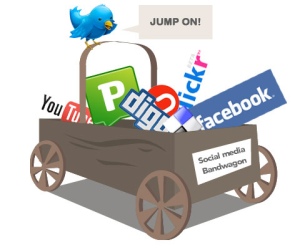If you are responsible for communications in your organization, you will know the value of having a clear strategy and a way of evaluating it. This post will discuss some social media tools and give you ideas on how to include social media appropriately in your communications plan and measure its effectiveness.

Setting your goal
A good social media strategy should take into consideration goals, target audiences AND technological implications. For example, while it is true to say that most of the CGIAR’s constituents are not even online, many of its strategic audiences, such as donors, researchers and policy makers, will be. The Social Media Strategic Planning Worksheet from We Are Media will help you plan your social media strategy.
Here are some questions you might want to answer as you start to include a social media component in your communications strategy:
- What communications objective do you want to try to support with social media?
- What are the benefits, both tangible and intangible, that a social media strategy might offer?
- What value does your social media strategy provide to your organization and/or stakeholders?
- What type of quantitative and qualitative information do you need to track to measure your success or learn how to improve your social media strategy?
In the Blogging for impact post, you will find a number of reasons for establishing a blog. Some of the key objectives that this social media tool can help your organization achieve include: increased visibility, enhanced reputation, knowledge sharing and audience participation. These objectives don’t just apply to blogging; they can also be extended to many other social media activities such as microblogging.
Introducing a social media component into your communications strategy requires an understanding of your chosen tools and how the network dynamics work. If you are interested in learning more about strategic social media planning and have a project that you want to introduce to the Social Web, you may want to sign up for the ICT-KM Program’s Online Social Media Workshop to be held from May 25 to June 12, 2009.
Measure as you go
It is fairly simple to experiment with social media and throw out an experiment that is not working for you. Think small, low risk, frequent experiments, rather than trying to build “the perfect system” and over-investing in any one tool until you can see its value to your organization.
For example, you can create a blog as an alternative to a traditional email newsletter. By creating a central online archive for your news items, you can:
- track traffic to individual posts – find out how many times a blog post has been viewed by using your blog software or a tool like Google Analytics).
- read any comments you might get when you post entries that specifically ask for feedback. People are more likely to respond to open-ended questions.
- monitor incoming links to your newsletter address and individual posts. You can monitor traffic sources (i.e. referrers in your traffic analysis reports) and keep an eye on the sites that link to your blog, simply by leveraging the search engine indexes. For example, you can set up a Google Alert to check who has linked to a specific URL or to your site, as their pages are registered with the Google index. You can also use Yahoo Site Explorer to monitor incoming links.
- analyze those blog posts that are more popular and, accordingly, adjust your posting style, choice of topics, areas you want to focus on, etc.
The above approach relies on quantitative metrics. For a great list of other metrics, please see Rachel Happe’s blog post on Social Media Metrics.
Social listening
In the early phases of using social media, you will typically try things out and begin “listening” for the response as indicated by page views, links, responses and actions of your target audience.
Check out Beth Kanter’s blog post about evaluating first projects, where she links to Geoff Livingston’s post called “Getting Social Media Approved By Your Boss,” in which he talks about organizational culture change and resistance, but with the emphasis on the importance of a proof of concept project. Here’s an excerpt:
First off, we recommend using a pilot project to get through the door. Reticence is often conquered by a win, and the best way to provide a win is via a pilot project. Tips to ensuring you choose the right pilot project:
- Begin with some form of listening or monitoring. You must be in tune with your social web community if you want this to work. Hopefully you are doing this before you begin, but just in case…
- Simple and relatively low cost is good. When there is fear involved, an easy, relatively affordable project is an easy thing to sign off on.
- Short timeframes help, too. You want to make this a quick test.
- Make sure you have a measurable goal. Look at your strategy, it will tell you exactly what to measure. You must be able to attain ROI. That is why attaining something worthwhile is essential, whether it’s micro-donations, market intelligence, feedback on a new product, click-throughs to a store, registrants for a value added webinar, or some other measurable result. You must be able to declare victory.
Social media has been around for a while (social bookmarking was already all the rage back in 2005 when Yahoo acquired Del.icio.us). However, it’s the growth in the adoption and use of social networks that has started to generate increasing traffic to the websites that get bookmarked, shared, commented on, and spread in whatever way through the networks. This is driving the demand for data related to social media: how many people are following us? what topics do they find interesting? who else is in their networks?
The first thing to do, as stated in the excerpt above, is to identify the goal you want to measure and choose the analysis tools that best cater for the job. For example, you can create buzz around an event so you engage participants before, during and after the event, the success of which can be measured in terms of the number of times your event information is viewed. You can also check the spread of an individual message across networks.
A great starting guide for measuring traffic generated by social media can be found at HOW TO: Track Social Media Analytics. Another article about reputation monitoring focuses on the tools you might want to set up to find out what is being said about your organisation, project or initiative so that you can participate in the conversation.
Capturing intangibles
Of course, using quantitative metrics is not the only way of evaluating your social media ROI. Successful communications often involves intangibles, like, say, a donor reading a blog post that tells the story of a project and, as a result, begins to engage more deeply to support the work involved. Or it could be about people who start following your Twitter messages and gain a deeper appreciation for, say, food and hunger in the world and start making small changes in their own lives. These things require a deeper listening – such as finding stories, carrying out interviews with people from your target audience, etc. For more on this, here is another blog post from Beth Kanter on intangibles as part of ROI.
As you get a sense of how social media is helping you achieve your communications strategy, you can begin to incorporate social media evaluation into your overall communications evaluation work:
- keep anything that is working
- adjust those aspects that might be working
- stop doing anything that isn’t working
Note: Sometimes, it takes both experimentation and time to find out if something is working. So don’t give up too quickly.
Additional Resources
About this post. Originally developed by the Social Media Workshop facilitators, expanded by Antonella Pastore, edited by Mary Schneider.


 some
some 
